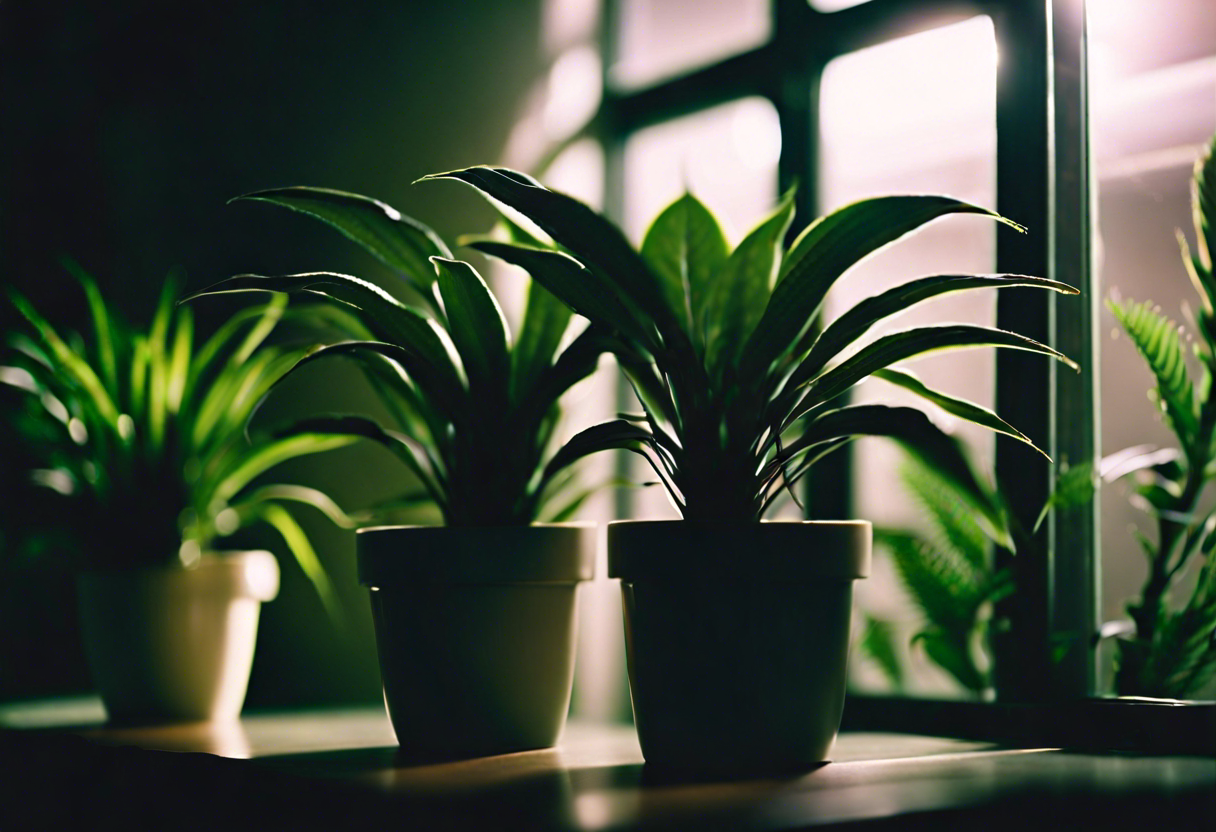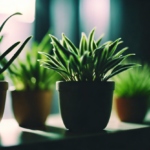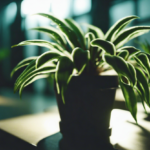Best Tall Indoor Plants for Low Light Conditions
When it comes to decorating your indoor space, incorporating tall indoor plants can add a touch of elegance and create a sense of tranquility. However, finding the right plants for low light conditions can be a challenge. Luckily, there are several beautiful options that thrive in such environments. Here are some of the best tall indoor plants for low light conditions:
-
Snake Plant (Sansevieria trifasciata): Also known as "mother-in-law’s tongue," the snake plant is a popular choice for low light areas. It has long, thick leaves that grow upright, giving it a tall and slender appearance. Snake plants can tolerate a wide range of light conditions, making them a versatile choice for any room.
-
ZZ Plant (Zamioculcas zamiifolia): The ZZ plant is another excellent option for low light conditions. It has glossy, dark green leaves that grow in a feather-like pattern. The ZZ plant is highly adaptable and can survive in low light areas where other plants struggle. It is also known for its air-purifying properties, making it a beneficial addition to any indoor space.
-
Parlor Palm (Chamaedorea elegans): The parlor palm is a compact palm species that can reach up to 6 feet in height. It has delicate, feathery fronds that create an elegant and tropical ambiance. This plant thrives in low light conditions, making it an ideal choice for offices, bedrooms, or any space that lacks natural sunlight.
-
Dracaena (Dracaena spp.): Dracaena plants come in various species, all of which make great tall indoor plants for low light conditions. These plants have long, sword-like leaves that come in a range of colors and patterns. They are known for their air-purifying abilities and can tolerate low light areas with ease.
-
Chinese Evergreen (Aglaonema spp.): Chinese evergreens are popular for their attractive foliage and ability to thrive in low light conditions. They have broad, leathery leaves that come in a variety of colors, including shades of green, silver, and red. Chinese evergreens are low-maintenance and can add a pop of color to any room.
Incorporating tall indoor plants into your low light spaces is not only aesthetically pleasing but also beneficial for your well-being. The snake plant, ZZ plant, parlor palm, dracaena, and Chinese evergreen are just a few examples of plants that can thrive in these conditions. Remember to consider the specific lighting needs of each plant and provide adequate care to ensure their health and growth. With the right selection, your low-light room can be transformed into a lush green oasis.
Understanding the Lighting Requirements of Indoor Plants
When it comes to growing indoor plants, one of the most important factors to consider is lighting. Different plants have different lighting needs, and it’s essential to understand these requirements to ensure the health and growth of your indoor greenery. In this article, we will delve into the lighting requirements of indoor plants to help you make informed decisions when selecting and caring for your tall plants in low light conditions.
Firstly, it’s crucial to note that most indoor plants can be categorized into three lighting categories: low light, medium light, and high light. Low light plants are those that can thrive in areas with minimal sunlight, such as rooms with small windows or limited exposure to natural light. These plants have adapted to survive in the shade of taller trees in their natural environments.
For those seeking tall plants for low light conditions, several species are well-suited to these environments. One of the most popular choices is the Snake Plant (Sansevieria trifasciata), also known as "Mother-in-Law’s Tongue." This plant is known for its ability to tolerate low light and can even thrive in fluorescent light settings. The Snake Plant’s leaves are tall, slender, and feature vibrant green colors, making it a visually appealing addition to any indoor space.
Another excellent option for low light conditions is the ZZ Plant (Zamioculcas zamiifolia). This plant has glossy, dark green, oval-shaped leaves that can grow tall and complement any interior decor. The ZZ Plant is highly adaptable and can tolerate low light, making it an ideal choice for offices or areas with minimal natural light.
If you’re looking for a statement-making plant, the Fiddle Leaf Fig (Ficus lyrata) is an excellent choice. Its large, violin-shaped leaves can grow tall, creating an eye-catching focal point in any room. While the Fiddle Leaf Fig prefers bright indirect light, it can tolerate lower light conditions, making it suitable for spaces that receive limited sunlight.
To ensure the well-being and growth of your tall indoor plants in low light environments, it’s crucial to provide them with proper care. While these plants can adapt to lower light conditions, it’s still essential to place them near a bright window or provide them with artificial lighting, such as grow lights. Additionally, be cautious not to overwater your plants, as they may not dry out as quickly in low light conditions.
Understanding the lighting requirements of indoor plants is essential for the successful cultivation of tall plants in low light conditions. By selecting species that are well-suited to these environments and providing them with adequate care and lighting, you can create a thriving indoor garden that brings life and beauty to your space. Take the time to research specific plant species’ lighting requirements and enjoy the rewards of lush, tall indoor plants in even the darkest corners of your home or office.
Easy-to-Maintain Tall Indoor Plants for Low Light Environments
When it comes to indoor gardening, finding the right plants for low light conditions can be a challenge. However, that doesn’t mean you have to give up on having beautiful tall plants in your home. There are several varieties of plants that thrive in low light environments and require minimal maintenance. Whether you have a dimly lit living room or a windowless office, here are some easy-to-maintain tall indoor plants that will thrive in low light:
Snake Plant (Sansevieria trifasciata)
The Snake Plant, also known as Mother-in-law’s Tongue, is a popular choice for low-light environments. This plant has tall, upright leaves that are often variegated with shades of green or yellow. Snake Plants are not only visually appealing, but they are also known for their air-purifying properties. They can tolerate a wide range of light conditions, making them ideal for low light spaces.
ZZ Plant (Zamioculcas zamiifolia)
The ZZ Plant is another excellent choice for low light environments. This plant has glossy, dark green leaves that grow upright and can reach impressive heights. ZZ Plants are known for their ability to thrive in low light conditions and require minimal watering. They can tolerate neglect and are perfect for busy individuals or those who are new to indoor gardening.
Cast Iron Plant (Aspidistra elatior)
The Cast Iron Plant is a hardy and resilient plant that can thrive in low light conditions. It has long, lance-shaped leaves that grow upright and can reach up to 2 feet in height. This plant is known for its ability to tolerate neglect and can survive in areas with minimal sunlight. It requires minimal watering and is an excellent choice for those who want a low-maintenance tall indoor plant.
Dracaena (Dracaena spp.)
Dracaenas are a diverse group of plants that come in various sizes and shapes. Some species, such as the Dracaena marginata and Dracaena fragrans, can grow tall and make beautiful statement plants. These plants have long, narrow leaves that come in different shades of green and sometimes have unique patterns. Dracaenas can tolerate low light conditions but also benefit from some indirect sunlight.
Pothos (Epipremnum aureum)
Pothos, also known as Devil’s Ivy, is a versatile plant that can thrive in various lighting conditions, including low light. It has cascading vines with heart-shaped leaves that can grow quite long. Pothos is an excellent choice for hanging baskets or for trailing down bookshelves or cabinets. It is low maintenance and only requires occasional watering.
These are just a few examples of tall indoor plants that can thrive in low light conditions. When selecting plants for low light environments, it’s important to consider their specific light requirements and choose varieties that are known to tolerate low light conditions. With proper care and lighting, you can enjoy the beauty and benefits of indoor plants, even in dimly lit spaces.
Creative Ways to Decorate with Tall Indoor Plants in Low Light Areas
When it comes to decorating low light areas with tall indoor plants, there are numerous creative possibilities that can transform these spaces into green havens. While low light conditions can pose a challenge for plant growth, many varieties thrive in such environments. By incorporating these plants into your interior design, you can bring life and vitality to any room. Here are some creative ways to decorate with tall indoor plants in low light areas.
-
Statement Corner: Turn a dimly-lit corner into a focal point by placing a tall indoor plant in a decorative pot. Choose plants with eye-catching foliage such as the snake plant (Sansevieria) or the ZZ plant (Zamioculcas zamiifolia). These plants not only add height to the space but also add texture and visual interest.
-
Vertical Gardens: If you’re limited on floor space, consider creating a vertical garden using hanging planters or wall-mounted containers. Choose trailing plants like pothos (Epipremnum aureum) or philodendron (Philodendron hederaceum) which can tolerate low light conditions. Arrange them in a vertical pattern to create a living wall of greenery.
-
Natural Room Dividers: Use tall indoor plants to create natural room dividers in open floor plans. Plants like bamboo palm (Chamaedorea seifrizii) or lady palm (Rhapis excelsa) can grow well in low light conditions and provide privacy while adding a touch of nature to the space.
-
Dramatic Centerpiece: Make a bold statement by placing a tall indoor plant as a centerpiece on a dining room table or a console table. Choose plants with vibrant foliage such as the fiddle leaf fig (Ficus lyrata) or the Swiss cheese plant (Monstera deliciosa). Pair them with neutral-colored pots or baskets to create a visually striking focal point.
-
Hanging Baskets: Utilize the vertical space in low light areas by hanging baskets filled with trailing plants. The spider plant (Chlorophytum comosum) and the heartleaf philodendron (Philodendron scandens) are excellent choices for this purpose. Hang them from the ceiling or place them on wall-mounted hooks to add depth and dimension.
-
Plant Shelves: Install floating shelves near windows or under skylights to create dedicated display areas for your tall indoor plants. This allows the plants to receive whatever natural light is available while adding a touch of greenery to the room. Choose plants like the cast iron plant (Aspidistra elatior) or the parlor palm (Chamaedorea elegans) that can tolerate low light conditions.
Decorating low light areas with tall indoor plants doesn’t have to be a challenge. By choosing the right plant varieties and implementing creative ideas, you can transform any dimly-lit space into a lush and inviting oasis. Incorporate these ideas into your interior design to create stunning visual effects while bringing the benefits of nature indoors. Remember to consider the specific lighting requirements of each plant and provide appropriate care to ensure their long-term health and growth.
Tips for Successfully Growing and Caring for Tall Indoor Plants in Low Light Spaces
When it comes to decorating indoor spaces, incorporating tall indoor plants can bring a touch of elegance and charm. However, the challenge arises when dealing with low light conditions. Luckily, there are a variety of tall indoor plants that can thrive in such environments. To successfully grow and care for these plants, consider the following tips:
1. Choose the right plant: When selecting tall indoor plants for low light spaces, opt for varieties that are known for their adaptability in low light conditions. Some popular options include the Snake Plant, ZZ Plant, and Peace Lily. These plants have the ability to tolerate and even thrive in areas with minimal natural light.
2. Consider indirect light: While low light conditions may not provide direct sunlight, indirect light is still necessary for the growth of indoor plants. Place your tall plants near a north-facing or east-facing window where they can receive some indirect sunlight. Avoid placing them in areas that are completely deprived of light.
3. Adjust watering frequency: With reduced light, tall indoor plants in low light areas tend to have slower growth rates, which means they require less water. Overwatering can lead to root rot and other issues. It’s important to allow the soil to dry out between waterings and check the moisture levels before watering again. Be mindful not to water excessively.
4. Use appropriate potting mix: Choosing the right potting mix is crucial for the health and growth of your tall indoor plants. Opt for well-draining soil mixes to prevent waterlogging. A mix of peat moss, perlite, and vermiculite or a commercial potting mix labeled for indoor plants can provide the ideal conditions for your plants.
5. Provide humidity: Indoor environments with low light tend to have lower humidity levels, which can affect the health of your tall indoor plants. Increase humidity by misting the foliage with water or placing a tray of water near the plants. Another option is to group your taller plants together, creating a microclimate of increased humidity around them.
6. Rotate the plants: To ensure even growth, rotate your tall indoor plants periodically. This helps to prevent the plant from leaning towards the light source and promotes balanced growth. Aim to rotate the plants every few weeks, allowing each side of the plant to receive adequate light.
7. Monitor for pests: Low light conditions can weaken the plants’ defenses, making them more susceptible to pests. Regularly inspect your tall indoor plants for any signs of pest infestation, such as webs, sticky residue, or yellowing leaves. If pests are detected, treat them promptly with organic or chemical insecticides, depending on your preference.
Growing and caring for tall indoor plants in low light spaces is possible with the right selection and proper care. By choosing appropriate plants, providing indirect light, adjusting watering, using suitable potting mix, maintaining humidity, rotating the plants, and monitoring for pests, you can enjoy the beauty and benefits of tall indoor plants in any low light environment. Remember to observe your plants closely and make adjustments as needed to ensure their optimal growth and health.
Conclusion
Having tall indoor plants that thrive in low light conditions can be a game-changer for any space. With the right knowledge and understanding of their lighting requirements, you can easily create a lush and vibrant environment even in areas with limited natural light.
Choosing the best tall indoor plants for low light conditions is crucial for their growth and overall well-being. Some excellent options to consider are the Dracaena, Snake Plant, and ZZ Plant. These plants not only tolerate low light conditions but also add a touch of elegance and beauty to any room they are placed in.
Understanding the lighting requirements of indoor plants is essential for their successful growth. While most plants thrive in bright, indirect light, there are some varieties that can adapt and thrive in low light conditions. These plants have evolved to store and convert energy more efficiently, making them ideal for locations with limited natural light.
For those looking for easy-to-maintain tall indoor plants for low light environments, the Pothos and Peace Lily are perfect choices. These plants are known for their ability to withstand neglect and can still thrive in low light conditions. With minimal care and occasional watering, they can continue to grow and enhance your space effortlessly.
In addition to their beauty, tall indoor plants in low light areas can be creatively incorporated into any interior design scheme. They can be placed in corners to add vertical interest and fill empty spaces. Hanging planters, shelf displays, and even terrariums can also be used to showcase these tall plants, adding an extra touch of style and sophistication to the room.
To ensure the successful growth and care of tall indoor plants in low light spaces, it is important to follow a few key tips. First, avoid overwatering as it can lead to root rot. Instead, allow the soil to dry out slightly between waterings. Second, dust the leaves regularly to remove any buildup, which can hinder photosynthesis. consider rotating the plants every few weeks to ensure an even distribution of light and prevent uneven growth.
Incorporating tall indoor plants into low light areas is a great way to bring life and beauty to any space. By understanding their lighting requirements, choosing the right plants, and following proper care techniques, you can create a thriving indoor garden that will enhance the ambiance of your home or office. So go ahead, embrace the beauty of tall indoor plants in low light conditions and enjoy the tranquility they bring to your space.


